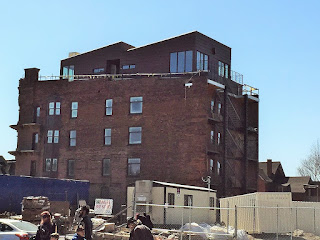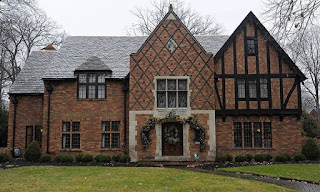Not for $1.00
Detroit is full of beautiful homes and neighborhoods, and we’ve all heard
the stories of people buying a mansion for $1.00, and on, and on. While that
may have been true, you can expect to pay a bit more for a house with great bones
in a great neighborhood today. I toured most every neighborhood of any renown
in Detroit, and came away very excited about the possibility of being a part of
Detroit’s renaissance. “I could save Detroit”, I told myself “One house at a time!”
As one would logically expect, with so much urban flight out of the city
in the days of segregation, the suburbs flourished and the city’s urban core
began its downward spiral. What I want to share with you in this article is the
beauty of these inner city neighborhoods, and let you see what I saw, a city on
the brink of a true renaissance. There is so much opportunity here to develop
and restore existing vacant homes and land. “Is it too early?” I asked that
question and was told more than once that, “It’s already happening”. Is there
still an opportunity? Yes indeed, but the time is now… it’s here for the
taking.
Boston Edison- Berry Gordy House
Boston Edison- Charles T. Fisher House
Boston Edison- Henry Ford House
Boston Edison- S.S. Kresge House
Boston-Edison
Historic District (shown above) is a historic
neighborhood located in the north side of the city center. It consists of over
900 homes, and street after street of beautiful, specimen traditional American and
European architecture styles are represented. Boston-Edison is one of the
largest residential historic districts in the nation, and was listed on the
National Register of Historic Places in 1975. Once home to Henry Ford, Charles
Fisher, William Briggs, Barry Gordy, Joe Louis, Sebastian Kresge, and Ty Cobb
to name a few notables.
Corktown
Corktown- The restaurant Gold Cash Gold
Corktown- The historic train station
Corktown: The
Great Irish Potato Famine of the 1840s caused heavy Irish migration to the
United States in droves, and by the middle of the 19th century, they were the
largest ethnic group settling in Detroit. They
were primarily from County Cork, and thus the neighborhood came to be known as
Corktown. The area is quickly becoming gentrified with old red brick factory buildings
being converted to lofts. I tried to eat at Gold Cash Gold, a former jewelry
and loan pawn shop that is now one of the hottest restaurants in the city, the
wait at 4:00 in the afternoon was 2-1/2 hours!
Easter Market- Flower Market
Eastern Market- Farmers Market
Eastern Market: A historic commercial district also listed on the National
Register of Historic Places. Eastern Market is the largest historic public
market district in the United States, and the Eastern Market farmer's
distribution center is the largest open-air flowerbed market in the United
States. On Saturdays, about 45,000 people shop the city's historic Eastern
Market. Factory and warehouse buildings are rapidly being converted to lofts.
Indian Village
Indian Village- Edwin Nelson House
Indian Village- James Burgess Book Jr. House
Indian Village- Mary S. Smith House
Indian Village: The district has a number of architecturally-significant homes built in the early 20th century. A number of the houses have been substantially restored, and many others well kept up. Many of the homes were built by prominent architects, such as Albert Kahn for some of the area's most prominent citizens, such as Edsel Ford.
Lafayette Park - Ludwig Mies van der Rohe Townhomes
Lafayette Park - Ludwig Mies van der Rohe Townhomes
Lafayette Park - Ludwig Mies van der Rohe Townhomes
Lafayette Park is a high rise, International Style, residential
neighborhood east of Downtown Detroit. The area is part of the Mies van der
Rohe Residential District listed in the National Register of Historic Places. Built
between 1958-60, the 78-acre, 186 unit, development by Ludwig Mies van der
Rohe, is a collection of one and two-story townhomes, a small neighborhood
shopping center, and two high-rises set adjacent to a 19-acre
municipally-operated park.
Midtown- The David Whitney, Jr, House
Midtown: The
David Whitney House was built between 1890 and 1894 by the lumber baron David
Whitney Jr., who was considered not only one of Detroit's wealthiest
personalities, but also one of Michigan's wealthiest citizens. The house is
estimated to have cost $400,000 (approx. $10,500,000 today). Constructed using
pink Jasper, it has 21,000sq.ft, 52 rooms, 20 fireplaces, and numerous Tiffany
glass windows. The Tiffany glass windows have been estimated to be worth more
than the house itself. The
grand staircase features a massive stained glass window portraying a knight,
paying homage to the various members of the Whitney family who were knighted,
as well as their lineage to Royal blood line in England. The house was the
first residential home in Detroit to have an elevator.
Midtown- Home of the new Red wings Stadium (under construction)
Midtown- New construction in the "Loft style" with materials not in keeping with old Detroit
Midtown- Interesting adaption of contemporary architecture atop a classic old Detroit building
Midtown is the future
home of the new Detroit Red Wings Stadium and has the most significant amount
of newly vacant land for development- a good and bad thing!
Palmer Woods estate
Palmer Woods estate
Palmer Woods- The Bishop Gallagher house
Palmer Woods: One of the most significant and largest homes (at 40,000sq.ft.) in all of Detroit is located here, the 62-room Bishop Gallagher residence. The home was built for the Fisher Brothers (Body by Fisher) in 1925, who hired the Boston firm of McGinnis and Walsh, specialists in ecclesiastical architecture, to design the Tudor Revival mansion. Upon completion, the Fishers gave the mansion to Bishop Michael Gallagher, of the Roman Catholic Archdiocese of Detroit.
West Canfield Historic District
West canfield is also adjacent to the Detroit based, Shinola
West Canfield Historic District is listed on the National Register of Historic Places in 1971 (the listing of these homes is something the city has been very good at doing!). The revitalized 1870s era neighborhood is one of the residential areas near the Detroit Institute of Art in Midtown.
The Nain Rouge, with arms up in victory rides atop his flaming and smoking, Cockroach-mobile
The Nain Rouge Parade was filled with thousands of participants, mostly in costume in hopes of being unrecognized by the Nain Rouge
I was invited to a pre-“Nain Rouge” party at one of the restored homes which was located just a block off the parade route. The Nain Rouge, French for "red dwarf", is a mythical creature whose appearance is said to presage terrible events for the city, with sightings that began as far back as 1701. Called the Marche du Nain Rouge, this event is a revival of an early tradition in the legend of the Nain Rouge. At the conclusion of the parade, an effigy of the imp was destroyed, thus banishing the evil spirit from the city for another year.
The Albert Capitol Park
The Albert Capitol Park- The site of Detroit's Underground Railway
The Albert Capitol Park- Entrance
The Albert Capitol Park- A lift Living room
The Albert Capitol Park- Room with a view
The Albert Capitol Park- The Social Room
The Albert Capitol Park- Multi-media Laundry Room
The Albert Capitol Park- Residents Dog Wash Station
And lastly but not least, Downtown: Residentially speaking, downtown is 100% leased up, and there is a waiting list for one of the newly converted lofts that have been made from former office towers. Forget about buying a condo downtown because the buildings were sold with incentives so rich that it is worth it for the developer to hold it for the required 8 years before reselling the building or units. The incentives set off a a race among developers who can’t buy them fast enough, covert them, and lease them. There isn’t a single condo for sale in downtown Detroit under $1,000,000. The neatest loft building we toured was The Albert on Capital Park, a building whose history includes having been built on the site of Detroit’s historic Underground Railroad which helped slaves gain their freedom. The Albert has every amenity a young college recruit could want: A Doorman, Social Room with Billiards and Bar, a community Dog Wash room, a Laundry room with multi-media, and the coolest view of the city from every room of your apartment.
In conclusion, Detroit is a fun place to be. Real estate is a play, and the time is now. My one concern for development is that with the city in its current state of disrepair is that the city leaders may feel compelled to approve real estate development and projects that aren't up to par as far as the city’s rich architectural heritage is concerned. Please, please, please, dear city leaders of Detroit, don’t do what so many other cities have done of late -- approving second rate projects filled with second rate design and materials just to get something going. remember: Too many rental apartment buildings are your next slum.
There is real opportunity in both jobs and in housing. If I were a recent college graduate, Detroit would be high on my list of places to consider living and working. Have a look.
Stay tuned for DETROIT Part V of V.
Goodnight Moon.
























































